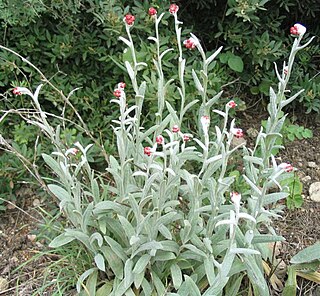
The genus Helichrysum consists of an estimated 600 species of flowering plants in the sunflower family (Asteraceae). The type species is Helichrysum orientale. They often go by the names everlasting, immortelle, and strawflower. The name is derived from the Ancient Greek words ἥλιος and χρῡσός.

Leucospermum is a genus of evergreen upright, sometimes creeping shrubs that is assigned to the Proteaceae, with currently forty-eight known species.

Murfatlar is a town in Constanța County, Northern Dobruja, Romania. It officially became a town in 1989, as a result of the Romanian rural systematization program.

Xerochrysum bracteatum, commonly known as the golden everlasting or strawflower, is a flowering plant in the family Asteraceae native to Australia. Described by Étienne Pierre Ventenat in 1803, it was known as Helichrysum bracteatum for many years before being transferred to a new genus Xerochrysum in 1990. It is an annual up to 1 m (3.3 ft) tall with green or grey leafy foliage. Golden yellow or white flower heads are produced from spring to autumn; their distinctive feature is the papery bracts that resemble petals. The species is widespread, growing in a variety of habitats across the country, from rainforest margins to deserts and subalpine areas. The golden everlasting serves as food for various larvae of lepidopterans, and adult butterflies, hoverflies, native bees, small beetles, and grasshoppers visit the flower heads.
Immortelle is another name for everlastings, plants in the family Asteraceae. It may also refer to:

Verticordia helichrysantha, commonly known as coast featherflower or Barrens featherflower, is a flowering plant in the myrtle family, Myrtaceae and is endemic to the south-west of Western Australia. It is a small, woody, open-branched shrub with crowded, linear leaves and small yellow flowers from May to September.

Eublemma minutata, the scarce marbled, is a species of moth of the family Erebidae. It can be found everywhere in Europe, except for Luxembourg, the Netherlands, the northern part of Russia and various islands. In Asia, it can be found only in Lebanon.
Vulcaniella pomposella is a moth of the family Cosmopterigidae. It is found from France, the Baltic Region and Ukraine to the Mediterranean region.

Coronidium elatum, commonly known as the white paper daisy or tall everlasting, is a perennial herbaceous shrub in the family Asteraceae found in open forests in eastern Australia. A woody shrub 0.6 to 2 m tall, it has white flowers which appear in spring. It was known as Helichrysum elatum for many years until it was finally reviewed in 2008.
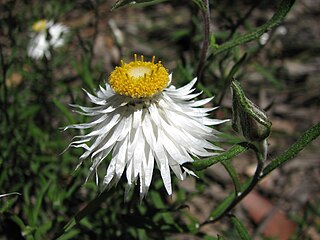
Helichrysum leucopsideum, commonly known as satin everlasting, is a flowering, perennial herb in the family Asteraceae. It is grows in all states of Australia except Queensland and the Northern Territory. It has white, terminal flower heads and narrow, woolly leaves.

Ptocheuusa inopella is a moth of the family Gelechiidae. It is found from France to Russia and from Denmark and Sweden to Austria and Hungary. It has also been recorded from Greece.
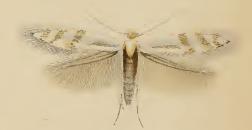
Bucculatrix gnaphaliella is a moth of the family Bucculatricidae. It is found from Sweden and the Baltic region to the Pyrenees, Italy and Romania and from France to Russia. It was described by Georg Friedrich Treitschke in 1833.

Digitivalva reticulella is a moth of the family Acrolepiidae found in most of Europe, except Ireland, Great Britain, the Netherlands, France, Portugal, Slovenia, much of the Balkan Peninsula, and Lithuania.
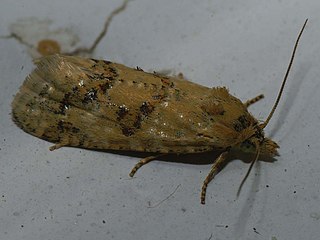
Aethes williana, the silver carrot conch, is a species of moth of the family Tortricidae. It was described by Nikolaus Joseph Brahm in 1791. It is found in most of Europe, Trans-Caspia, Asia Minor, Mongolia, north-western Africa and Iran. It is found in dry, sandy and chalky habitats.

Aethes languidana is a species of moth of the family Tortricidae. It was described by Josef Johann Mann in 1855. It is found in France, Spain, Portugal and Italy and on Corsica and Sardinia.
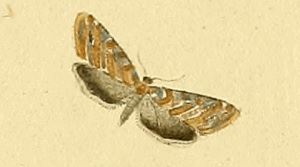
Eupoecilia cebrana is a species of moth of the family Tortricidae. It is found in Sweden, France, Germany, Denmark, Poland, Austria, Slovakia, Estonia, Latvia, Lithuania, Russia, North Macedonia and Greece.

Leucospermum arenarium is a lax, evergreen shrub, with arching and drooping branches, that has been assigned to the family Proteaceae. It has loosely spaced, upright, greyish, narrowly egg-shaped to line-shaped leaves, mostly without teeth and flattened globe-shaped flower heads of 5–7 cm across, consisting of mostly creamy, seldom yellow flowers, that curve in the bud to the center of the head. From the center of the flowers emerge curved styles that jointly give the impression of a pincushion. The common name in English is Redelinghuys pincushion. It only occurs in a very small area in the Western Cape province of South Africa. It flowers between July and October. Unlike in related species the flowers are pollinated by hairy-footed gerbils and striped field mice.

Helichrysum splendidum is a species of flowering plant in the family Asteraceae, found in Africa and Yemen A hardy evergreen perennial, it occurs from the Southern Cape to Ethiopia along the eastern escarpment mountains, favouring rocky places in fynbos, grassland and savanna biomes. It forms mound-shaped aggregations 1–2 meters high, sometimes covering entire hillsides. The species is found in South Africa, Eswatini, Lesotho, Tanzania, Ethiopia, South Sudan, Malawi, Zimbabwe, Zambia and Yemen. The distribution of this species is clearly anthropogenic, that is, closely linked to the movements of man through the ages.

Helichrysum pumilum, commonly known as dwarf everlasting, is a rosette herb from the family Asteraceae. It is endemic to Tasmania, where it is commonly found in the West and Southwest of the island state. It is distinctive by its inflorescence, with the flower stalk being densely matted in fine white hairs and the daisy-like flower head having numerous pink or white ray floret-like bracts.

Helichrysum monogynum, also known as red tinderbox, is a species of flowering plant within the family Asteraceae. The species is listed as endangered due to its restricted range within 8 km² of suitable habitat and the threat of habitat degradation due to urbanisation and recreational activities.

















